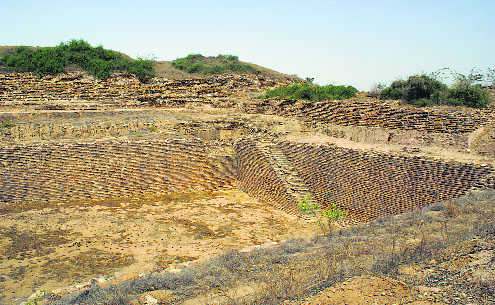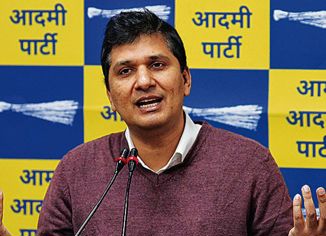
One of the great reservoirs of the ruined city of Dholavira.
Hugh & Colleen Gantzer
WE saw it in Dhaula Vira: a ruined megalopolis covering an island-hillock , a bet, in the saline deserts of the Rann of Kachch. There, those mysterious people of the Indus Valley Civilization had tapped sparse rains and seasonal rivulets in vast reservoirs, sustaining an industrial complex exporting to Sumeria and other West Asian states. Sadly, their civilization collapsed, possibly because of increasing salinity in their fields and forests. But, as we discovered, memories of their advanced water harvesting techniques trickled down through the generations to the present day.
Outside a village in the Rann, we clambered over a wooden stile and into a large, gentle, depression shaded by spreading trees. Not far from the stile was a cemented trough filled with water. And all around were wells, some of which had been abandoned and partially filled with earth. One of the wells was still in use and had water about 9 meters down. This was a working Virda: a seepage well. We looked in, fascinated. It was lined with fairly close fitting logs up to two meters from the top, the spaces between the logs being stuffed with ferns to allow water to trickle in. From there on the walls of the well were made of tightly packed ferns wadded together. A villager explained that Virdas were always built in low-lying ground, preferably where there were mango trees because they indicated the presence of water-saturated soil.
“ No one can say how long a Virda will last: maybe many years, maybe a few weeks. We fill up the old ones that dry up, make new ones”
"Can anyone draw water from a Virda?"
"That is not our custom. Water is very precious, it must not be spoilt. So we choose from volunteers. They draw water from the Virdas and fill the trough for the village."
"How long has this Virda been giving you water"
He smiled and nodded. "This is a very good Virda. Many times we have renewed the logs and the filtering ferns. It has served us for 300 years and its water is sweeter than your packaged drinking water."
He looked around, shouted, and loped away, scaring cattle that were trying to climb over the stile.
In an arid land, water-harvesting wells had to be protected. The aesthetic Solanki rulers of Gujarat went beyond human sentries invoking an entire pantheon of divine beings to safe-guard their precious water. In 1084, they constructed a major water purification and flood-control facility: the Sahasralinga Talav, the Lake of a Thousand Lingas.
It's an intriguing structure set in a grove of old trees. It is dry now and has only been partially excavated but enough has been unearthed to give a good idea of its original purpose. Water from a seasonal river was tapped to cascade down an inclined channel into a large, circular, pool. The pool's walls were lined with concentric tiers of increasing size. At a right angle to the inlet, there was an outlet. This allowed the water stored in the pool to flow out, after it had risen to more than half-way up the pool. This water was led into a step-lined canal ending in three circular sluice gates, set side by side. From there it took a sharp right turn before it was retained in the main reservoir. The stepped sides of the reservoir held small Shiva shrines and ended in a Shiva temple with a long, covered, forecourt with 48 pillars, stretching down the spine of the reservoir. The massive, high, sanctum of the temple must once have dominated this complex and had probably been crowned by a tower which later collapsed.
In the absence of any explanation of the, legendary, 'filtration system' we came to our own conclusions. Water from the river poured into the circular, stepped, pool where it was forced to swirl around, aerating it and exposing it to sunlight. This first pool also served as a sedimentation tank, allowing suspended particles to settle to the bottom. In all likelihood, this pond was stocked with carp which fed on insects and algae, further cleaning the water of pests and impurities. The upper surface of this water, the clearest part, was then led off into a long channel filled with living plants such as water hyacinth and strelitzia or ginger lily which absorb harmful metals and other dangerous substances. These water-loving plants grow rapidly and so the sluice gates were installed to prevent them from clogging the third stage of this filtration system where the water flowed over a bed of charcoal and only then was allowed to enter into the drinking water reservoir sanctified by the Shiva shrines and the great Shiva temple.
It was here that we recalled the experience of an IAS officer posted to a drought-prone district in Bihar. In flash of insight he realised that the rainwater harvesting sacred tanks in the shrines of many faiths also served to recharge the aquifers in the area. These underground layers of water-holding rocks or sand are tapped by wells. He launched a scheme to restore the old check-dams and village ponds which fell into disuse during the British era. The next summer there was no drought in his district.
The water filtered and stored in the Shasralinga Talav, similarly charged the aquifers of the Solanki wells including the monumental Rani ki Vav.
They call vavs step wells but an ordinary well is to a vav what a scooter is to a Lamborghini. Vavs are a succession of cool, and superbly carved, leisure pavilions descending, tier after decorated tier, to the water level far below.
We walked down a long flight of steps to the topmost of the many pavilions. From here on the vav was roofed and it was invitingly damp after the dry heat of the surface. All around us, beautiful, and rather voluptuous, sculptures enriched the walls, pillars, lintels and virtually every available surface, except the ones we walked on. Here, in intricate detail, was the entire Indic pantheon including suggestions of the primeval snake deities probably dating back to pre-Vedic, Dravidian, times,
Sacred serpents, in many cultures, have been associated with the earth, water and rejuvenation because of their ability to shed their old skin and emerge glistening and radiant. This belief has survived in a significant way in the southern states, particularly Kerala. We've encountered them in the sacred places around which great cities have grown. In the mansions of old families, they sit green and protected, still a source of awe to descendants born in distant lands and other civilizations. And in especially revered areas, their presence protects forests where endangered trees and shrubs and even fish still thrive, safe and defiant against the bulldozers of 'progress' They are the powerful serpa kavus, the snake shrines, and the most powerful, reputedly, is Mannarsala. In Alappuzha district, we threaded our way down a road winding through a dense, green, moist forest. Pitted dark laterite walls appeared between us and the rising jungle. Then, atop a low parapet, was a long row of stone idols of snake deities. They were not statues sculpted as works of art, to be admired. They were consecrated idols, revered with offerings of flowers, some of them daubed with the vermillion and saffron powder of recent worship.
For us, however, the significance of the temple is that it protects a great ecological reservoir. The forest is primeval. Shrubs had grown into bushes, bushes into gnarled old trees, trees soared with their canopies spreading high above. Lianas as thick as human arms looped themselves from tree to tree and coiled their way to the top, seeking the sun. The ground below was soft, moist and loamy. A stream gurgled over rocks glistening in the shifting light and shade of this serpent guarded jungle. Forests trap and conserve moisture, hardwoods absorb carbon emissions, winds and birds spread greenery over the surrounding terrain. Such profound ecowisdom led to the founding of a green faith by Rajasthan's Jambeshwar.. We learnt about him quite by accident. We were driving through the starkly beautiful, but inhospitable landscape of Rajasthan, when we saw a blur of green. Curious, we turned towards it and discovered that it was village in a cooling grove of trees. The greening began far on the outskirts of the village. Grass spread out from the first bushes dotted around the village. The thorn scrub merged into thickets; the thickets grew into groves; the groves give way to large trees. The men and women were tall and handsome. To our amazement, we saw peafowl, partridge and chinkara deer wandering fearlessly around the village. We also spotted blackbuck grazing with their cattle. This green miracle in the desert belonged to the Bisnois: the followers of a creed of 29, bis-noi, principles laid down by a visionary herdsman. That was more than 500 years before 'The Environment' became a fashionable buzz-word.
We sat on a khatia in the dappled shade of the village, sipped glasses of milk thick with yellow cream, and were told the tale of their folk-hero turned deity: Jambeshwar.
He was born in a little Rajasthani village in 1451. As was the custom in those days, it was his job to take his family's herds out to graze. There wasn't much fodder, or many grazing lands, but the observant Jambeshwar noticed that wherever the thorn trees spread their sparse shade, grass grew and survived the scorching sun of this arid land. He also saw that when the trees acted as wind-breaks, the droppings left by his herds, chinkara deer and black-buck, fertilized the land causing more grass to grow. Otherwise, the wind blew everything away and the land became arid again. The young herds-boy began to appreciate the self-renewing cycle of nature which binds all living things into an inter-dependent web. If he could use this web, desert dew would not evaporate and the whole land would be greened.
This is the story we've heard repeated often, but as Jambeshwar looked after his herds during those long days in the desert, other insights came to him. If trees protected the land then green trees shouldn't be cut therefore only deadwood should be removed. But there might be little creatures in that wood, so such timber should be washed to remove the insects that might be hiding in it. Meat, of course, was anathema; so was dirt of any sort: everyone should bathe every morning, filter water through a cloth, and wear white so that you could see any living creature that might have taken shelter in your clothes. Out of his observations were born the Twenty Nine Principles that, eventually, became the precepts of a new, environmental, faith. Consequently, his followers, came to be called the Bis-nois, the 'Twenty-niners'. Jambeshwar is now referred to as Jamboji. "We are vegetarians and we don't keep sheep of goats. If we don't kill animals why should we breed them for others to kill?" they said. They seemed to be prosperous though we wondered how their very ecologically sane creed allowed them to make a living in this austere land.
Driving out of Bisnoi-country we fell into line behind three powerful motor-cycles roaring down the road ahead of us, like outriders. When all our efforts to overtake them failed we asked why there was so much traffic on this rural road. Our guide grinned and said: "Look at the cans mounted on both sides of their carriers." Large zinc canisters were clamped on their bikes, like strange rocket-launchers. "Those Harley-Davidsons are carrying milk to the markets of Jodhpur." He nodded. "Bisnois, of course!" Clearly our ancient ecowisdom, crystallsed into faith, continues to sustain us.
Veteran travel writers, the duo has researched ecological and environmental practices worldwide





















